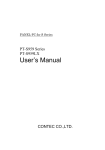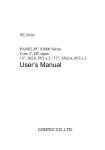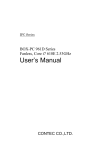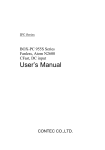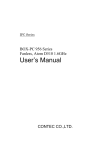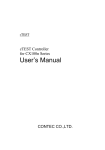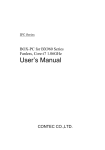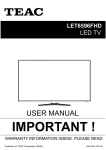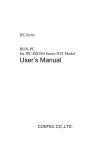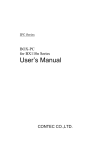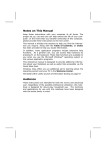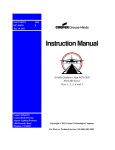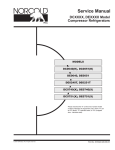Download User`s Manual
Transcript
IPC Series PANEL-PC S959 Series Fanless, Atom D2550 1.86GHz User’s Manual CONTEC CO.,LTD. Check Your Package Thank you for purchasing the CONTEC product. The product consists of the items listed below. Check, with the following list, that your package is complete. If you discover damaged or missing items, contact your retailer. If you use driver & utility software set, download it form the CONTEC's Web site. Product Configuration List Name 1. Panel-PC 2. Waterproof packing 3. Mounting bracket 4. CFast protection A 5. CFast protection B 6. Screws to fix HDD 7. Power supply connector set Housing Contact Pcs. 1 1 10 1 1 4 1 4 Name 8. DVI-VGA convertion adapter 9. Cable clamp 10. Slot cover 11. Screws to fix slot cover 12. Product guide (this sheet) 13. IPC Precaution List 14. Warranty Certificate 15. Serial Number Label 16. Low-profile PCI card spacer Pcs. 1 1 2 6 1 1 1 1 1 If you need product manual, driver & utility software set, download it form the CONTEC's Web site. PT-S959HXP2 User’s manual i Copyright Copyright 2014 CONTEC Co., Ltd. All Rights Reserved. No part of this document may be copied or reproduced in any form by any means without prior written consent of CONTEC Co., Ltd. CONTEC Co., Ltd. makes no commitment to update or keep current the information contained in this document. The information in this document is subject to change without notice. All relevant issues have been considered in the preparation of this document. Should you notice an omission or any questionable item in this document, please feel free to notify CONTEC Co., Ltd. Regardless of the foregoing statement, CONTEC assumes no responsibility for any errors that may appear in this document or for results obtained by the user as a result of using this product. Trademarks Intel, Intel Atom, Intel Core and Celeron are registered trademarks of Intel Corporation. MS, Microsoft and Windows are trademarks of Microsoft Corporation. Other brand and product names are trademarks of their respective holder. ii PT-S959HXP2 User’s manual Table of Contents Check Your Package ................................................................................................................................ i Copyright .................................................................................................................................................ii Trademarks ..............................................................................................................................................ii Table of Contents ...................................................................................................................................iii 1. INTRODUCTION 1 About the Product ................................................................................................................................... 1 Features ............................................................................................................................................ 1 Supported OS ................................................................................................................................... 2 Customer Support.................................................................................................................................... 3 Web Site ........................................................................................................................................... 3 Limited One-Year Warranty ................................................................................................................... 3 How to Obtain Service ............................................................................................................................ 3 Liability ................................................................................................................................................... 3 Safety Precautions................................................................................................................................... 4 Safety Information ........................................................................................................................... 4 Caution on the PT-S959 Series........................................................................................................ 4 2. SYSTEM REFERENCE 7 Specification ............................................................................................................................................ 7 Power Management Features................................................................................................................ 11 Power Requirements ............................................................................................................................. 11 Power Consumption....................................................................................................................... 11 Physical Dimensions ............................................................................................................................. 12 3. HARDWARE SETUP 13 Before Using the Product for the First Time........................................................................................ 13 Hardware Setup ..................................................................................................................................... 14 Attaching the CFast Attachment Fittings...................................................................................... 14 Attaching the HDD ........................................................................................................................ 14 Attaching the FG ............................................................................................................................ 15 Fastening the Cable........................................................................................................................ 15 Hardware Setup .............................................................................................................................. 16 Installation Requirements .............................................................................................................. 17 PCI Card Installation ..................................................................................................................... 19 4. EACH COMPONENT FUNCTION 23 Component Name.................................................................................................................................. 23 PT-S959HXP2 User’s manual iii Front view Bottom view.............................................................................................................23 System Configuration ............................................................................................................................24 Component Function .............................................................................................................................25 LED: POWER, ACCESS, STATUS .............................................................................................25 DC Power Input Connector : DC-IN .............................................................................................25 Power switch: POWER SW ...........................................................................................................26 Line out Interface: LINE OUT.......................................................................................................26 Mic in Interface: MIC ....................................................................................................................26 USB Ports: USB .............................................................................................................................26 Giga bit-Ethernet: LAN A – B .......................................................................................................27 Serial Port Interface: SERIAL A - B .............................................................................................28 DVI Interface: DVI ........................................................................................................................29 CFast Card Connector (Primary IDE Connection): CFast 1.........................................................31 Serial-ATA: S-ATA .......................................................................................................................32 5. BIOS SETUP 33 Introduction............................................................................................................................................33 Starting Setup.........................................................................................................................................33 Using Setup.....................................................................................................................................34 Getting Help....................................................................................................................................34 In Case of Problems .......................................................................................................................34 A Final Note about Setup ...............................................................................................................34 Main Menu.............................................................................................................................................35 Setup Items .....................................................................................................................................35 Main .......................................................................................................................................................36 Advanced ...............................................................................................................................................37 PCI Subsystem Settings .................................................................................................................38 ACPI Settings .................................................................................................................................39 CPU Configuration.........................................................................................................................40 IDE Configuration ..........................................................................................................................41 USB Configuration.........................................................................................................................42 Super I/O Configuration.................................................................................................................43 Serial Port A Configuration ...........................................................................................................44 Serial Port B Configuration............................................................................................................45 Hardware Monitor ..........................................................................................................................46 Chipset ...................................................................................................................................................47 Host Bridge .....................................................................................................................................48 Memory Frequency and Timing ....................................................................................................49 Intel IGD Configuration .................................................................................................................50 South Bridge ...................................................................................................................................51 TPT Devices ...................................................................................................................................53 Boot ........................................................................................................................................................55 Security ..................................................................................................................................................56 iv PT-S959HXP2 User’s manual Save & Exit ........................................................................................................................................... 57 POST Beep ............................................................................................................................................ 60 6. APPENDIX 61 Memory Map ......................................................................................................................................... 61 I/O Port Addresses ................................................................................................................................ 62 Interrupt Level List ............................................................................................................................... 63 POST Codes .......................................................................................................................................... 64 SERIAL I/O Address and Register Function ....................................................................................... 67 Watch-Dog-Timer ................................................................................................................................. 73 Battery ................................................................................................................................................... 77 7. LIST OF OPTIONS PT-S959HXP2 User’s manual 79 v vi PT-S959HXP2 User’s manual 1. Introduction 1. Introduction About the Product This product is a fanless PANEL-PC for embedded use based on Intel (R) Atom processor D2550 and a NM10 chipset. Adoption of the long life power saving LED and Intel (R) Atom processor offers low power consumption while ensuring sufficient performance. The “resource-saving PC” contributes downsizing and power-saving of equipment to reduce your running cost and to promote energy efficiency. It has extended interfaces such as 1000BASE-T, USB2.0, and serial. CPU and chipset are embedded type with which this product could be reliable to use because of stable supply. This product is available in the following 1 model: - 2 PCI-slots model and panel mount type equipped with Intel Atom Processor D2550 1.86GHz PT-S959HXP2-DC7000 (15-inch touch panel, LCD (XGA), Memory 4GB, with 2 PCI slots, without OS / CFast / 2.5-inch HDD) Features - Contributing to reduction of running cost and promotion of energy efficiency Power consumption is less due to adoption of the low power consumption LED backlight and dual core processor Intel (R) Atom processor D2550, low power consumption, approximately 66W*1 even at a high load condition, is achieved at the same time sufficient performance is ensured, contributing to the lesser running cost. *1 Maximum value of power consumption with input power of 24VDC under fully-loaded conditions. - Reliable design by fanless construction This product employs a fanless construction (design does not use fan motors as these components have a finite lifetime) with CONTEC's unique heat dissipation technology and features reliable design. - High definition supported DVI external display output This product has the up to 1920 x 1200 pixels DVI external display output as standard feature. A stand-alone two-display application which, for example, displays the screen on a big LCD TV separately from the main LCD, can be built. Also, with the accompanying analog RGB (15 pin HD-SUB) conversion adapter, connecting to an analog RGB display is supported. - Remote power management function to reduce operation tasks This product supports timed/automated system start-up (Resume By Alarm). For example, it enables unattended operation, such as starting to show information of an establishment in unison at opening time. Also, it supports system start-up externally via network (Wake On LAN) and modem (Power On by Ring). It encourages significant labor saving in operation. - Major types of peripherals are supported with rich interfaces including the two PCI card slots It has a variety of extended interface such as 1000BASE-T x 2, USB2.0 x 4, serial x 4, CFast card slot x 1 and PCI card slot x 2. The case also houses a 2.5-inch SATA drive bay for easy disk replacement. PT-S959HXP2 User’s manual 1 1. Introduction - Falling-off prevention tools and cable clamps provided to avoid trouble caused by disconnected cable This product stays trouble-free, being equipped with USB removal prevention fitting and cable clamp for connectors with no locking mechanism, such as USB cable, and with hardware to properly mount and avoid falling out of CF card. - A wide range of power supplies (10.8 - 31.2VDC) supported As the product supports a wide range of power (10.8 - 31.2VDC), it can be used in a variety of power environments. The separately available AC adapter adds support for 100VAC power. - Touch panel enables keyboard-less operation. These products have analog touch panel enabling mouse emulation using driver software. Supported OS - 2 Windows 7 Professional PT-S959HXP2 User’s manual 1. Introduction Customer Support CONTEC provides the following support services for you to use CONTEC products more efficiently and comfortably. Web Site Japanese English Chinese http://www.contec.co.jp/ http://www.contec.com/ http://www.contec.com.cn/ Latest product information CONTEC provides up-to-date information on products. CONTEC also provides product manuals and various technical documents in the PDF. Free download You can download updated driver software and differential files as well as sample programs available in several languages. Note! For product information Contact your retailer if you have any technical question about a CONTEC product or need its price, delivery time, or estimate information. Limited One-Year Warranty CONTEC products are warranted by Contec Co., Ltd. to be free from defects in material and workmanship for up to one year from the date of purchase by the original purchaser. Repair will be free of charge only when this device is returned freight prepaid with a copy of the original invoice and a Return Merchandise Authorization to the distributor or the CONTEC group office, from which it was purchased. This warranty is not applicable for scratches or normal wear, but only for the electronic circuitry and original products. The warranty is not applicable if the device has been tampered with or damaged through abuse, mistreatment, neglect, or unreasonable use, or if the original invoice is not included, in which case repairs will be considered beyond the warranty policy. How to Obtain Service For replacement or repair, return the device freight prepaid, with a copy of the original invoice. Please obtain a Return Merchandise Authorization number (RMA) from the CONTEC group office where you purchased before returning any product. * No product will be accepted by CONTEC group without the RMA number. Liability The obligation of the warrantor is solely to repair or replace the product. In no event will the warrantor be liable for any incidental or consequential damages due to such defect or consequences that arise from inexperienced usage, misuse, or malfunction of this device. PT-S959HXP2 User’s manual 3 1. Introduction Safety Precautions Understand the following definitions and precautions to use the product safely. Safety Information This document provides safety information using the following symbols to prevent accidents resulting in injury or death and the destruction of equipment and resources. Understand the meanings of these labels to operate the equipment safely. DANGER DANGER indicates an imminently hazardous situation which, if not avoided, will result in death or serious injury. WARNING WARNING indicates a potentially hazardous situation which, if not avoided, could result in death or serious injury. CAUTION CAUTION indicates a potentially hazardous situation which, if not avoided, may result in minor or moderate injury or in property damage. Caution on the PT-S959 Series Handling Precautions WARNING - Always check that the power supply is turned off before connecting or disconnecting power cables. - Procedures that could result in serious injury or loss of human life should never be performed from a touch panel. Use system design methods that can guard against input errors. - Do not modify the product. - Always turn off the power before inserting or removing circuit boards or cables. - This product is not intended for use in aerospace, space, nuclear power, medical equipment, or other applications that require a very high level of reliability. Do not use the product in such applications. - If using this product in applications where safety is critical such as in railways, automotive, or disaster prevention or security systems, please contact your retailer. - Do not attempt to replace the battery as inappropriate battery replacement poses a risk of explosion. - For battery replacement, contact your retailer as it must be performed as a process of repair. - When disposing of a used battery, follow the disposal procedures stipulated under the relevant laws and municipal ordinances. 4 PT-S959HXP2 User’s manual 1. Introduction CAUTION - - - - - Do not use or store this product in a location exposed to high or low temperature that exceeds range of specification or susceptible to rapid temperature changes. Example: - Exposure to direct sun - In the vicinity of a heat source Do not use this product in extremely humid or dusty locations. It is extremely dangerous to use this product with its interior penetrated by water or any other fluid or conductive dust. If this product must be used in such an environment, install it on a dust-proof control panel, for example. Avoid using or storing this product in locations subject to shock or vibration that exceeds range of specification. Do not use this product in the vicinity of devices that generate strong magnetic force or noise. Such products will cause this product to malfunction. Do not use or store this product in the presence of chemicals. To clean this product, wipe it gently with a soft cloth dampened with either water or mild detergent. Do not use chemicals or a volatile solvent, such as benzene or thinner, to prevent pealing or discoloration of the paint. This product’s case may become hot. To avoid being burned, do not touch that section while this product is in operation or immediately after turning off the power. Avoid installation in a location where people may come into contact with that section. CONTEC does not provide any guarantee for the integrity of data on CFast. Always disconnect the power cable from the receptacle before connecting or disconnecting any connector. To prevent corruption of files, always shutdown the OS before turning off this product. CONTEC reserves the right to refuse to service a product modified by the user. In the event of failure or abnormality (foul smells or excessive heat generation), unplug the power cord immediately and contact your retailer. To connect with peripherals, use a grounded, shielded cable. Do not use any sharp-pointed object such as a mechanical pencil to touch the touch panel. Doing so may scratch the touch panel, resulting in malfunctions. - Do not subject the touch panel to shock as doing so may break it. - When the surface or frame of the touch panel has become dirty, wipe it with neutral detergent. Do not wipe the touch panel with thinner, alcohol, ammonia, or a strong chlorinated solvent. Use a protective sheet (available as an option) if the touch panel is used where it can easily collect dust and dirt. - It is a characteristic of analog touch panels that their resistance may vary with changes to the ambient environment (temperature and humidity) and with their own aging, resulting in the deviation of the detection point. If this is the case, calibrate the touch panel again to re-set calibration data. - LCD may have a few bright spots that are always on or a few black spots that are always off. Color irregularity may also occur depending on the viewing angle. This however is due to the structural characteristics of the LCD; therefore, it is not a product fault. - Burn-in on TFT Display “Burn-in” may occur if the same display is retained for a long time. Avoid this by periodically switching the display so that the same display is not maintained for a long time. * Burn-In : Phenomenon characterized by a TFT display as a result of long-time display of the same screen where a shadow-like trace persists because electric charge remains in the LCD element even after the patterns are changed. PT-S959HXP2 User’s manual 5 1. Introduction - The CFast card connector and 2.5-inch HDD slot do not support hot plugging. CFast cards and 2.5-inch HDDs cannot be removed or inserted while the power is on. Do not remove or install CFast cards or 2.5-inch HDDs or connect to CFast cards or 2.5-inch HDDs while the unit is turned on. This product may malfunction or cause a failure. - Component Life: (1) Battery---The internal calendar clock and CMOS RAM are backed by a Lithium primary battery. The backup time at a temperature of 25°C with the power disconnected is 7 years or more. (2) Touch panel--- The operating lifetime of the touch panel is at least 1 million touches (as tested by mechanical touching under 250g of force at a rate of two presses per second). (3) LCD backlight--- Display brightness decreases over time with use. The operating lifetime of the backlight is 50,000 hours (the time until the brightness is lowered to 50% of the initial value). * Replacement of expendables is handled as a repair (there will be a charge). * Component life is not guaranteed value but only referential value. FCC PART 15 Class A Notice NOTE This equipment has been tested and found to comply with the limits for a Class A digital device, pursuant to part 15 of the FCC Rules. These limits are designed to provide reasonable protection against harmful interference when the equipment is operated in commercial environment. This equipment generates, uses, and can radiate radio frequency energy and, if not installed and used in accordance with the instruction manual, may cause harmful interference to radio communications. Operation of this equipment in a residential area is likely to cause harmful interference at his own expense. WARNING TO USER Change or modifications not expressly approved the manufacturer can void the user's authority to operate this equipment. 6 PT-S959HXP2 User’s manual 2. System Reference 2. System Reference Specification Table 2.1. Functional Specification < 1 / 2 > Model PT-S959HXP2-DC7000 Assembly type Panel mounted CPU Intel® Atom™ Processor D2550 (1.86GHz) Chip set Intel® Atom™ D2550 + Intel® NM10 BIOS BIOS (mfd. by AMI) Memory Graphic 4GB ( 204pin SO-DIMM x 1), PC3-8500 DDR3 SDRAM Controller Intel® GMA3650 (Built in Intel® Atom™ Processor D2550) Multi-monitor function supported *1 LCD type Touch panel External display output Video RAM Main memory shared Video BIOS 64KB(C0000H-CFFFFH) LCD type 15-inch TFT color LCD, XGA(1024 x 768), 16,770,000 colors Backlight LED method, The ON/OFF software can control. Resolution 2048 x 2048 (emulated in 1024 x 768 mode) Detection method Resistive-film analog type Connection Internal USB port DVI *2 640 x 480, 800 x 600, 1,024 x 768, 1,152 x 864, 1,280 x 600, 1,280 x 720, 1,280 x 768, 1,280 x 960, 1,280 x 1,024, 1,360 x 768, 1,400 x 1,050, 1,600 x 900, 1,600 x 1,200, 1,856 x 1,392, 1,920 x 1,080, 1,920 x 1,200RB (16,770,000 colors) Analog RGB 640 x 480, 800 x 600, 1,024 x 768, 1,152 x 864, 1,280 x 600, 1,280 x 720, 1,280 x 768, 1,280 x 960, 1,280 x 1,024, 1,360 x 768, 1,400 x 1,050, 1,600 x 900, 1,600 x 1,200, 1,856 x 1,392, 1,920 x 1,080, 1,920 x 1,200 (16,770,000 colors) Audio HD Audio compliant, LINE OUT x 1, MIC IN x 1 Serial ATA I/F 2.5 HDD bay x 1, CFast card slot x 1 LAN*3 Realtek 8111E Controller 1000BASE-T/100BASE-TX/10BASE-T x 2 (Wake On LAN support) USB USB 2.0-compliant 4 port Serial RS-232C (general-purpose): 2ch (SERIAL PORT1,2), 9-pin D-SUB connector (male) Baud rate: 50 - 115,200bps *1 : A multi-screen display function using the main LCD and an external display. The “Twin” option is, however, not available for a combination with an external DVI-connected display. “Extended desktop” or “Intel ® dual display clone” can be used instead. *2 : Display of the DVI-connected screen becomes active after the Windows starts up. *3 : Care about ambient temperature when using 1000BASE-T. Refer to “Installation Requirements” in chapter 3 for details. PT-S959HXP2 User’s manual 7 2. System Reference Table 2.1. Functional Specification < 2 / 2 > Model PT-S959HXP2-DC7000 General-purpose I/O None Hardware monitoring Monitoring CPU temperature, board temperature, power voltage Watch dog timer Software programmable, 255 level (1sec - 255 sec), Causes a reset upon time-out. Expansion board slot PCI slot x 2 Usable board dimension : 240 mm (Max.) Real-time clock NM10 integrated, The real-time clock is accurate within 3 minutes (at 25C) per month, Lithium backup battery life : 7 years or more Power Management Power management setup via BIOS, Power On by Ring / Wake On LAN, Supports PC98/PC99 ACPI Power management Interface External display 1 port (29 pin DVI-I connector ), DVI-analog RGB conversion adapter attachment Audio LINE OUT: 3.5 Stereo mini jack, Full-scale output level 1.2Vrms (Typ.), MIC IN: 3.5 Stereo mini jack, Full-scale input level 1.5Vrms (Typ.) CFast card slot 1 slot, CFast card Type I, bootable No CFast cards are installed. Power supply 2.5-inch HDD slot 1 slot, 2.5-inch HDD, bootable LAN*2 2 port (RJ-45 connector) No HDDs are installed. USB 4 port (A-TYPE connector) RS-232C 2 port (9pin D-SUB connector [male]) Power supply connector 12 - 24VDC *4 Input power supply voltage 10.8 - 31.2VDC Current consumption 12VDC: 5.2A (Max.) Expansion board power supply capacity +12V: 1A, 24VDC: 2.8A (Max.) +5V: 2A, +3.3V: 1A, -12V: 0.5A, -5V: Not supplied External device power supply capacity CFast card slot: +3.3VDC 1A (500mA per slot), USB port: +5VDC 2A (500mA per slot), HDD slot: +5VDC 1.1A (1100mA per slot) Waterproofing and dust-proofing Front panel IP65 standard Panel cut dimensions (mm) 358 (W) x 289 (H) Physical dimensions (mm) 373 (W) x 125.4 (D) x 304 (H) (internal-panel depth) (Storage device isn't included) Weight 6.8kg *4: 8 Use a power cable shorter than 3m. PT-S959HXP2 User’s manual 2. System Reference Table 2.2. Installation Environment Requirements Model Operating temperature *5 PT-S959HXP2-DC7000 0 - 50C Storage temperature -10 - 60C Operating humidity 10 - 90%RH (No condensation) Floating dust particles Not to be excessive Corrosive gas None Noise resistance Vibration resistance Line noise AC line / 2kV *6, Signal line/1kV (IEC61000-4-4 Level 3, EN61000-4-4 Level 3) Static electricity resistance Contact discharge / 4kV (IEC61000-4-2 Level 2, EN61000-4-2 Level 2), Atmospheric discharge / 8kV (IEC61000-4-2 Level 3, EN61000-4-2 Level 3) Sweep resistance When HDD is turned on *7 : 10 - 50Hz/0.5G 25 min. each in x, y, and z directions (JIS C60068-2-6-compliant, IEC60068-2-6-compliant) When HDD is turned off *7 : 10 - 57Hz/semi-amplitude 0.15 mm 57 - 150Hz/1.5G 40 min. each in x, y, and z directions (JIS C 60028-2-6-compliant, IEC 60068-2-6-compliant) Impact resistance 10G, half-sine shock for 11 ms in x, y, and z directions (JIS C60068-2-27-compliant, IEC68-2-27-compliant) Grounding Class D grounding, SG-FG / continuity *5 : For more details on this, please refer to chapter 3, “Installation Requirements”. *6 : When using AC-DC power supply unit FSP065-RAB (FSP). *7 : When using optional hard disk PC-HDD100S (CONTEC). PT-S959HXP2 User’s manual 9 2. System Reference Display Optical Specifications Table 2.3. Display Optical Specifications Parameter Condition = 180° Visual angle (vertical) CR=10 Visual angle (horizontal) = 0° = +90° Display. Monochrome = -90° Display in white Surface brightness (at center) Min. Typ. 70deg 80deg 70deg 80deg 70deg 80deg 70deg 80deg 320cd/m2 400cd/m2 * “Surface brightness” represents a numerical value per display. The expected brightness through a touch panel is about 80% lower than the above value. Contrast ratio (CR) = Figure 2.1. Brightness at screen center with white displayed Brightness at screen center with black displayed Definition of viewable range CAUTION The above optical specification data shows optical characteristics of the liquid crystal in the display; the data does not represent the actual view on the display or its viewing angles. 10 PT-S959HXP2 User’s manual 2. System Reference Power Management Features - Support both ACPI (Advanced Configuration and Power Interface) and legacy (APM) power management. - ACPI v2.0 compliant - APM v1.2 compliant - Support hardware automatic wake-up Power Requirements Your system requires a clean, steady power source for reliable performance of the high frequency CPU on the product, the quality of the power supply is even more important. For the best performance makes sure your power supply provides a range of 10.8 V minimum to 31.2 V maximum DC power source. Power Consumption For typical configurations, the CPU card is designed to operate with at least a 60W power supply. The power supply must meet the following requirements: - Rise time for power supply: 2 ms - 30 ms The following table lists the power supply’s tolerances for DC voltages: Table 2.4. DC voltage tolerance DC Voltage Acceptable Tolerance + 12 - 24VDC + 10.8 - 31.2VDC PT-S959HXP2 User’s manual 11 2. System Reference Physical Dimensions PT-S959HXP2-DCxxxx Figure 2.2. 12 Physical Dimensions (PT-S959HXP2-DCxxxx) PT-S959HXP2 User’s manual 3. Hardware Setup 3. Hardware Setup Before Using the Product for the First Time Follow the next steps to set up this product: STEP1 By referring to the information in this chapter, install, connect and set this product. STEP2 Connect cables. Connect the cable of necessary external devices, such as keyboard and a mouse, to this product using appropriate cables. STEP3 Turn on the power. After verifying that you have correctly followed steps 1 and 2, turn on the power. If you find any abnormality after turning on the power, turn it off and check to see if the setup has been performed properly. STEP4 Set up BIOS. By referring to Chapter 5, set up BIOS. This setup requires a keyboard. *1 Before using this product, be sure to execute “LOAD SETUP DEFAULTS” to initialize the BIOS settings to their default values. (See Chapter 5, “Main Menu.”) CAUTION Be sure to connect the keyboard and mouse to it before turning the power on for the first time. PT-S959HXP2 User’s manual 13 3. Hardware Setup Hardware Setup - Before you start, be sure that the power is turned off. Remove only those screws that are explained. Do not move any other screw. Attaching the CFast Attachment Fittings (1) After inserting a CFast Card, fasten the bundled CF attachment fittings with a screw. Figure 3.1. Attaching the CFast Attachment Fittings CAUTION - Insert the CFast Card face up. - Screw holes may be damaged if screws are tightened with a torque greater than the specified torque. The specified tightening torque is 3 - 3.5kgfcm. Attaching the HDD (1) Remove the hard disk bracket from the main body. (2) Attach the hard disk to the hard disk bracket and secure it by tightening the four screws. (3) Insert the hard disk bracket with the hard disk attached into the main body, and secure it by tightening the screws. Figure 3.2. Attaching the HDD CAUTION - Insert the Hard disk face up. - Screw holes may be damaged if screws are tightened with a torque greater than the specified torque. The specified tightening torque is 3 - 3.5kgfcm. 14 PT-S959HXP2 User’s manual 3. Hardware Setup Attaching the FG (1) Use screws to attach the FG. * Attached screw (M3 x 8) Figure 3.3. Attaching the FG CAUTION The FG pin of this product is connected to the GND signal of the DC power connector (DC-IN). Note that the connection cannot be cut off. Screw holes may be damaged if screws are tightened with a torque greater than the specified torque. The specified tightening torque is 5 - 6kgfcm. Fastening the Cable This product comes with clamps for fixing cables. Fastening the LINEOUT, USB Cable The system unit has a hole for attaching cable clamp. Using a cable clamp for a cable with lock-less connector, such as the LINEOUT and USB Cable, prevents the connector from being unplugged. Use the cable ties and cable clamps appropriately according to the connecting states and wiring directions of cables. Figure 3.4. Attaching the cable clamp PT-S959HXP2 User’s manual 15 3. Hardware Setup Hardware Setup PT-S959HXP2-DCxxxx (1) Cut out a panel according to the following dimensions to mount the main unit. Figure 3.5. Dimensions of Panel Opening (2) Place the waterproof packing in the groove on the front face of the main body and insert the main body into the panel from the external side. Figure 3.6. Attaching the waterproof packing (3) Hold the attachment fittings from the inside of the panel. Figure 3.7. Hardware Setup CAUTION Screw holes may be damaged if screws are tightened with a torque greater than the specified torque. The specified tightening torque is 5 - 6kgfcm. 16 PT-S959HXP2 User’s manual 3. Hardware Setup When using VESA standard 100mm mounting holes The main body has mounting holes according to VESA standard 100mm. When using a VESA standard 100mm stand or the like, attach it as shown the following figure. Figure 3.8. Installation of VESA metal fittings Installation Requirements Be sure that the ambient temperature is within the range specified in the installation environment requirement by making space between the product and device that generates heat or exhaust air. Installed angle which is recommended 45° Installed angle of this product which is recommended is 0 - 45°. Except for that, the temperature specification of this product might not be filled. Figure 3.9. Installed angle which is recommended CAUTION Note that even though the ambient temperature is within the specified range, an operational malfunction may occur if there is other device generating high heat; the radiation will influence the product to increase its temperature. PT-S959HXP2 User’s manual 17 3. Hardware Setup Distances between this product and its vicinity Figure 3.10. Distances between this product and its vicinity CAUTION Do not install this product into the fully-sealed space except the case in which the internal temperature is adjustable by equipment such as air conditioner. Troubles such as operational malfunctions could be occurred by the temperature increase caused by long-term usage. Ambient temperature In this product, the ambient temperature is decided from the multiple measurement points as shown below. When making use of the product, the air current should be adjusted to prevent that all the temperatures measured at the measurement points exceed the specified temperature. Figure 3.11. Measurement points of ambient temperature 18 PT-S959HXP2 User’s manual 3. Hardware Setup PCI Card Installation (1) Be sure the power is turned off. (2) Remove the top cover. Figure 3.12. Remove the top cover (3) Remove the brace base with PCI card brace. Figure 3.13. Remove the brace base with PCI card brace PT-S959HXP2 User’s manual 19 3. Hardware Setup (4) Let brace base and PCI card brace separate and install brace base by using 3 screws. Figure 3.14. Hold brace base (5) Insert PCI card into the slot and fasten it with screws. Figure 3.15. Insert PCI card (6) Make sure carefully that PCI card has been secured in the slot. Fix PCI card stably by brace and screw. Figure 3.16. Fix PCI card 20 PT-S959HXP2 User’s manual 3. Hardware Setup (7) Replace the cover. Figure 3.17. Replace the cover. The location of brace base Brace base can be installed to 3 locations. Select one according to the size of your PCI card. Figure 3.18. The locaction of brace base Installation of low-profile PCI card Use attached spacer for installing low-profile PCI card. Figure 3.19. The installation of low-profile PCI card PT-S959HXP2 User’s manual 21 3. Hardware Setup 22 PT-S959HXP2 User’s manual 4. Each Component Function 4. Each Component Function Component Name Front view Bottom view Figure 4.1. Component Name Table 4.1. Component Function Name POWER-SW Function Power switch POWER LED Power ON display LED ACCESS LED HDD disk access display LED STATUS LED Status LED DC-IN DC power input connector LINE OUT Line out (3.5 PHONE JACK) MIC IN Mic in (3.5 PHONE JACK) USB USB port connector x 4 LANA Ethernet 1000BASE-T/100BASE-TX/10BASE-T RJ-45 connector LANB Ethernet 1000BASE-T/100BASE-TX/10BASE-T RJ-45 connector SERIALA Serial port A connector (9pin D-SUB/male) SERIALB Serial port B connector (9pin D-SUB/male) Slot 1 PCI card slot 1 Slot 2 PCI card slot 2 DVI-I Display (29pin female) CFast1 CFast card slot CFast2 Not supported HDD 2.5” HDD slot PT-S959HXP2 User’s manual 23 4. Each Component Function System Configuration Figure 4.2. System Configuration 24 PT-S959HXP2 User’s manual 4. Each Component Function Component Function LED: POWER, ACCESS, STATUS There are 3 LED in front of this product. Table 4.2. Display Contents of LED LED name POWER LED State Display contents OFF Indicates that this product is switched off. ON (Green) Indicates that this product is switched on. ACCESS LED ON (Orange) Indicates that the HDD device is being accessed. STATUS LED OFF You can control the behavior of LED from the user application. Flashing, ON (Red) You can control the behavior of LED from the user application. *1 *1 *1 This product does not support *1. DC Power Input Connector : DC-IN To supply the power, always use the power supply listed below. Rated input voltage : 12 - 24VDC Range of input voltage : 10.8 - 31.2VDC Power capacity : 12V 5.2A or more, 24V 2.8A or more Table 4.3. DC Power Connector Connector type 9360-04P (mfd. by ALEX) Pin No. Signal name 1 GND 2 GND 3 12 - 24V 4 12 - 24V Applicable connector on the connector side Housing Contact : 9357-04(mfd. by ALEX) or 5557-04R (mfd. by MOLEX) : 4256T2-LF(AWG18-24) (mfd. by ALEX) or 5556 (AWG18-24) (mfd. by MOLEX) Applicable connector on the connector side Voltage 2 - 30mS 12V Time Figure 4.3. Graph of Rise Time of Power Supply PT-S959HXP2 User’s manual 25 4. Each Component Function Power switch: POWER SW POWER SW is provided. Line out Interface: LINE OUT A line output connector is provided. You can plug a headphone or amplifier-integrated speakers into this connector. Mic in Interface: MIC A line output connector is provided. You can plug a headphone or amplifier-integrated speakers into this connector. Audio driver The audio driver is required to use the microphone input and line output interfaces. Install the appropriate audio driver for your OS from the CONTEC’s Web site. USB Ports: USB This product is equipped with 4 ports for USB 2.0 interface. Table 4.4. USB Connector 26 Pin No. Function 1 USB_VCC 2 USB- 3 USB+ 4 USB_GND PT-S959HXP2 User’s manual 4. Each Component Function Giga bit-Ethernet: LAN A – B This product is equipped with 2 ports for giga bit. - Network type Transmission speed * Max. network path length Controller : : : : 1000BASE-T/100BASE-TX/10BASE-T 1000M/100M/10M bps 100m/segment Realtek 8111E (LAN-A/B) Table 4.5. Giga bit-Ethernet Connector Pin No. LAN Transmit LED 8 Link LED 1 Function 100BASE-TX 1000BASE-T 1 TX+ TRD+(0) 2 TX- TRD-(0) 3 RX+ TRD+(1) 4 N.C. TRD+(2) 5 N.C. TRD-(2) 6 RX- TRD-(1) 7 N.C. TRD+(3) 8 N.C. TRD-(3) LEDs for display of network statuses: Right LED : Normal connection : Left LED : 10M: Off, 100M : Link LED Green ON, Operation: Green Blinking Operation LED Green, 1000M: Orange LAN drivers Install the appropriate LAN driver for your OS from the CONTEC’s Web site CAUTION - If you want to use WOL function, please select "Enable" at the item "Enable PME" of OS driver setting. PT-S959HXP2 User’s manual 27 4. Each Component Function Serial Port Interface: SERIAL A - B SERIAL A,B,C,D The product has 2 ports of RS-232C compliant serial ports supporting up to a baud rate of 115,200bps with a 16-byte transmission-dedicated data buffer and a 16-byte reception-dedicated data buffer. You can use “Chapter 5 BIOS Setup” to configure an I/O address, interrupt and unused state for each of the ports independently. (The same I/O address and IRQ cannot be shared with any other device.) Please refer to “Chapter 6 I/O Port Addresses” for more information on I/O address and register function. Table 4.6. SERIAL A, B I/O Addresses and Interrupts SERIAL I/O address Interrupt A 3F8h - 3FFh IRQ 4 B 2F8h - 2FFh IRQ 3 Table 4.7. Serial Port (A, B Connector) Connector used on the 9-pin D-SUB (MALE) product Pin No. Signal name 1 CD 2 RD Received data 3 TD Transmitted data Output Output 28 Meaning Carrier detect Direction Input Input 4 DTR Data terminal ready 5 GND Signal ground ----- 6 DSR Data set ready Input 7 RTS Request to send Output 8 CTS Clear to send Input 9 RI Ring indicator Input PT-S959HXP2 User’s manual 4. Each Component Function DVI Interface: DVI A DVI interface is provided. You can use it to connect a CRT (even a D-SUB 15 pin connector is acceptable by using the bundled DVI-analog RGB adapter) or a CONTEC Panel Link display. The connector is named DVI (DVI-I 29-pin connector). CAUTION Precautions when Using Additional Display - An additional display can be used to enable simultaneous screen display with the PANEL-PC main display. - If the resolution of the additional display is different from that of the PANEL-PC main display, the size of screen images on the additional display will be decreased or increased with lower image quality. - When using the main unit and touch panel function at the same time, use a USB connection for the touch panel. Table 4.8. DVI Connector Connector used on DVI-I 29 pin the product Pin No. Signal name Pin No. Signal name 13 14 N.C. +5V C1 C2 RED GREEN 15 GND C3 BLUE 16 17 18 HSYNC GND 10 DATA1+ 22 HPD DATA0DATA0+ DATA0 SHIELD N.C. N.C. DATA0 SHIELD C4 C5 8 9 DATA2DATA2+ DATA2 SHIELD N.C. N.C. DDC CLK DDC DATA VSYNC DATA1- Pin No. 1 2 3 4 5 6 7 11 12 Signal name DATA1 SHIELD N.C. PT-S959HXP2 User’s manual 19 20 21 23 CLK+ 24 CLK- 29 4. Each Component Function Table 4.9. DVI-analog RGB conversion adapter Connector type DVI-I 29 pin Signal on analog RGB Pin No. Signal name Pin No. Signal name 1 RED 9 +5V 2 GREEN 10 GND 3 BLUE 11 N.C. 4 N.C. 12 DDC DATA 5 GND 13 HSYNC 6 GND 14 VSYNC 7 GND 15 DDC CLK 8 GND For the LCDs that can be connected, please refer to “Chapter 7 List of Options”. Display driver Install the appropriate display driver for your OS from the CONTEC’s Web site. CAUTION - 30 You need to set the screen resolution if the display cable is not connected to this DVI-D interface at OS startup, but connected after OS startup (hereinafter referred to as “Late Insertion”). When the analog display is used, Windows MS-DOS may not be properly displayed in full-screen mode. This is because the frequency and resolution of Windows and MS-DOS (full-screen display) are the same due to the screen settings while the display parameters are different. For display, as only one parameter can be stored for one frequency or resolution, only either of Windows or MS-DOS screen can be displayed properly. In this case, change the resolution or display frequency of Windows so that it is not the same as for the MS-DOS display. PT-S959HXP2 User’s manual 4. Each Component Function CFast Card Connector (Primary IDE Connection): CFast 1 The CFast Card (Type I) can be connected. The CFast Card connector doesn't support hot plug. The pulling out opening of the CFast Card cannot be done in the state of power supply ON. Please neither pulling out opening of CFast in the state of power supply ON of this product nor come in contact with CFast. This product may malfunction or cause a failure. Table 4.10. CFast Card Connector Connector used CFast connector on the product Pin No. Signal name Pin No. Signal name PC1 CDI S1 GND PC2 GND S2 TX+ PC3 N.C. S3 TX- PC4 N.C. S4 GND PC5 N.C. S5 RX- PC6 N.C. S6 RX+ PC7 GND S7 GND PC8 LED PC9 N.C. PC10 N.C. PC11 N.C. PC12 N.C. PC13 +3.3V PC14 +3.3V PC15 GND PC16 GND PC17 CDO PT-S959HXP2 User’s manual 31 4. Each Component Function Serial-ATA: S-ATA It has serial-ATA-2.0-compliant controller. 2.5-inch SATA HDD can be connected to an onboard connector. Table 4.11. SATA Connector Connector used SATA connector on the product 32 Pin No. Signal name Pin No. Signal name PC1 N.C. S1 GND PC2 N.C. S2 TX+ PC3 N.C. S3 TX- PC4 GND S4 GND PC5 GND S5 RX- PC6 GND S6 RX+ PC7 +5V S7 GND PC8 +5V. PC9 +5V. PC10 GND PC11 N.C. PC12 GND PC13 +12V PC14 +12V PC15 +12V PT-S959HXP2 User’s manual 5. BIOS Setup 5. BIOS Setup Introduction This chapter discusses American Megatrends Inc.’s Setup program built into the FLASH ROM BIOS. The Setup program allows users to modify the basic system configuration. This special information is then stored in FLASH ROM so that it retains the Setup information when the power is turned off. The rest of this chapter is intended to guide you through the process of configuring your system using Setup. Starting Setup The BIOS is immediately activated when you first power on the computer. The BIOS reads the system information contained in the FLASH ROM and begins the process of checking out the system and configuring it. When it finishes, the BIOS will seek an operating system on one of the disks and then launch and turn control over to the operating system. While the BIOS are in control, the Setup program can be activated in one of two ways: 1 By pressing <Del> or <F2> immediately after switching the system on, or 2 By pressing the <Del> or <F2> key when the following message appears briefly at the screen during the POST (Power On Self-Test). Press <DEL> or <F2> to enter setup. If the message disappears before you respond and you still wish to enter Setup, restart the system to try again by turning it OFF then ON. Restart can be initiated by pressing the <Ctrl>, <Alt>, and <Delete> keys simultaneously. PT-S959HXP2 User’s manual 33 5. BIOS Setup Using Setup In general, you use the arrow keys to highlight items, press <Enter> to select, use the Page Up and Page Down keys to change entries, press <F1> for help and press <Esc> to quit. The following table provides more detail about how to navigate in the Setup program using the keyboard. Table 5.1. Using Setup Key Up Arrow Down Arrow Left Arrow Right Arrow ESC Move Enter Function Move to the previous item Move to the next item Move to the item on the left (menu bar) Move to the item on the right (menu bar) Main Menu: Quit without saving changes Submenus: Exit Current page to the next higher level menu Move to the item you desired + key Increase the numeric value or make changes - key Decrease the numeric value or make changes F1 key General help on Setup navigation keys F2 key Load previous settings F3 key Load the optimized defaults F4 key Save all settings changes to the FLASH ROM and exit Getting Help Press F1 to pop up a small help window that describes the appropriate keys to use and the possible selections for the highlighted item. To exit the Help Window press <Esc> key again. In Case of Problems If it is not possible to boot the computer after system settings have been changed and saved during setup, this product will need to be repaired. The best advice is to only alter settings which you thoroughly understand. To this end, we strongly recommend that you avoid making any changes to the chipset defaults. These defaults have been carefully chosen by both AMI and your systems manufacturer to provide the absolute maximum performance and reliability. If chipset settings are changed even slightly, it may become necessary to repair the unit. A Final Note about Setup The information in this chapter is subject to change without notice. 34 PT-S959HXP2 User’s manual 5. BIOS Setup Main Menu Once you enter the AMI BIOS Setup Utility, the Main Menu will appear on the screen. Use the arrow keys to select among the items and press <Enter> to accept and enter the sub-menu. Figure 5.1. Main Manu Setup Items The main menu includes the following main setup categories. - Main Use this menu to check basic system configuration, and to change system date. - Advanced Use this menu to set detailed function available for your system. - Chipset Use this menu to specify settings related to the chipset used. - Boot Use this menu to specify the boot settings. - Security Use this menu to change password to protect the security of your system. - Save & Exit Use this menu to load / save the setting, or to exit the setup menu. PT-S959HXP2 User’s manual 35 5. BIOS Setup Main Use this menu to check basic system configuration. Settings that can be configured in the Main menu are described in the table below. Table 5.2. Main Menu (Display only) Item General Description Explanation Language English Set the language used in the Setup Utility. System Date Month / Day / Year Set the system date. The day of the week is set automatically. System Time Hour : Minute : Second Set the system time. Administrator Display access permissions for the current setup. Items that can be configured depend on access permissions. Access Level 36 PT-S959HXP2 User’s manual 5. BIOS Setup Advanced You can set the detailed function of system. Following items are available. Figure 5.2. Advanced menu Settings that can be configured in the Advanced menu are described in the table below. Table 5.3. Advanced menu Settings Item Launch PXE OpROM Option Disabled Enabled Explanation Enable or Disable Boot Option for Legacy Network Devices. The following sub items are available: - PCI Subsystem Settings Use this menu to specify the pci subsystem settings. - ACPI Settings Use this menu to specify ACPI power management settings. - CPU Configuration Use this menu to specify the cpu configuration. - IDE Configuration Use this menu to specify the IDE configuration. PT-S959HXP2 User’s manual 37 5. BIOS Setup - USB Configuration Use this menu to specify the usb configuration. - Super I/O Configuration Use this menu to specify super I/O configuration, or to check hardware monitor. - Hardware Monitor Use this menu to check hardware monitor. PCI Subsystem Settings Use this menu to specify PCI subsystem settings. Figure 5.3. PCI Subsystem Settings Items that can be configured for PCI subsystem settings are described in the table below. Table 5.4. PCI Subsystem Settings Item PCI ROM Priority 38 Option Legacy ROM EFI Compativle ROM Explanation In case of multiple Option ROMs (Legacy and EFI Compatible), specifies what PCI Option ROM to launch. PT-S959HXP2 User’s manual 5. BIOS Setup ACPI Settings Use this menu to specify ACPI power management settings. Figure 5.4. ACPI Settings Items that can be configured for ACPI Settings are described in the table below. Table 5.5. ACPI Settings Item ACPI Sleep State Option Suspend Disabled S1 (CPU Stop Clock) S3 (Suspend to RAM) Wakeup by RI Control Wake On LAN Control Resume On RTC Alarm Disabled Enabled Disabled Enabled Disabled Enabled Explanation Select the highest ACPI sleep state the system will enter when the SUSPEND button is pressed. Enable / Disable Wakeup by Ring function. Enable / Disable Wake On LAN function. Enable or disable System wake on alarm event. When enabled, System will wake on the hr::min::sec specified. RTC Wake up Day 0 - 31 Select 0 for daily system wake up. 1-31 for which day of the month that you would like the system to wake up. RTC Wake up Hour 0 - 23 Select 0 – 23. For example enter 3 for 3am, and 15 for 3pm. RTC Wake up Minute 0 - 59 Select 0 – 59. RTC Wake up Second 0 – 59 Select 0 – 59. PT-S959HXP2 User’s manual 39 5. BIOS Setup CPU Configuration Use this menu to specify CPU settings. Figure 5.5. CPU Configuration Items that can be configured for CPU Configuration are described in the table below. Table 5.6. CPU Configuraiton Item Hyper-Threading Execute Disable Bit Limit CPUID Maximum 40 Option Explanation Disabled Enabled Enabled for Windows XP and Linux (OS optimized for Hyper-Threading Technology) and Disabled for other OS (OS not optimized for Hyper-Threading Technology). Disabled Enabled XD can prevent certain classes of malicious buffer overflow attacks when combined with a supporting OS (Windows Server 2003 SP1, Windows XP SP2, SuSE Linux 9.2, RedHat Enterprise 3 Update 3.) Disabled Enabled Disabled for Windows XP PT-S959HXP2 User’s manual 5. BIOS Setup IDE Configuration Figure 5.6. IDE Configuration Items that can be configured for IDE Configuration are described in the table below. Table 5.7. IDE Configuraiton Item SATA Controller(s) Configure SATA Port as Configure SATA as Option Disabled Enabled SATA Port CFast Card IDE AHCI PT-S959HXP2 User’s manual Explanation SATA Ports (1-2) Device Names if Present and Enabled. Select a configuration Select a configuration for SATA Controller. 41 5. BIOS Setup USB Configuration Figure 5.7. USB Configuration Items that can be configured for USB Configuration are described in the table below. Table 5.8. USB Configuraiton Item USB Devices: Option - Enabled Legacy USB Support USB transfer time-out Device reset time-out Device power-up delay Device power-up delay in seconds 42 Disabled Auto 1 sec 5 sec 10 sec 20 sec 10 sec 20 sec 30 sec 40 sec Auto Manual 1..40 Explanation Show only. Show USB Devices are connected. Enables Legacy USB support. AUTO option disables legacy support if no USB devices are connected. DISABLE option will keep USB devices available only for EFI applications. The time-out value for Control, Bulk, and Interrupt transfers. USB mass storage device Start Unit command time-out. Maximum time the device will take before it properly reports itself to the Host Controller. ‘Auto’ uses default value: for a Root port it is 100 ms, for a Hub port the delay is taken from Hub descriptor. Delay range is 1..40 seconds, in one second increments PT-S959HXP2 User’s manual 5. BIOS Setup Super I/O Configuration Figure 5.8. Super I/O Configuration Items that can be configured for Super I/O Configuration are described in the table below. Table 5.9. Super I/O Configuration Item AC Power Loss State Option Always OFF Always ON Explanation Set the state after power loss. Last State The following sub items are available: - Serial Port x Configuration (x = A..B) Use this menu to specify settings for serial ports A to B. PT-S959HXP2 User’s manual 43 5. BIOS Setup Serial Port A Configuration Figure 5.9. Serial Port A Configuration Items that can be configured for Serial Port A Configuration are described in the table below. Table 5.10. Serial Port A Configuration Item Serial Port Option Disabled Enabled Explanation Enable or Disable Serial Port (COM) Auto Change Settings 44 IO=3F8h; IRQ=4; IO=3F8h; IRQ=3,4,5,6,7,10,11,12; IO=2F8h; IRQ=3,4,5,6,7,10,11,12; IO=3E8h; IRQ=3,4,5,6,7,10,11,12; IO=2E8h; IRQ=3,4,5,6,7,10,11,12; Select an optimal setting for Super IO device. PT-S959HXP2 User’s manual 5. BIOS Setup Serial Port B Configuration Figure 5.10. Serial Port B Configuration Items that can be configured for Serial Port B Configuration are described in the table below. Table 5.11. Serial Port B Configuration Item Serial Port Option Disabled Enabled Explanation Enable or Disable Serial Port (COM) Auto Change Settings IO=2F8h; IRQ=3; IO=3F8h; IRQ=3,4,5,6,7,10,11,12; IO=2F8h; IRQ=3,4,5,6,7,10,11,12; IO=3E8h; IRQ=3,4,5,6,7,10,11,12; IO=2E8h; IRQ=3,4,5,6,7,10,11,12; PT-S959HXP2 User’s manual Select an optimal setting for Super IO device. 45 5. BIOS Setup Hardware Monitor Use this menu to check CPU temperature, system temperature, input voltage, and other system conditions. Figure 5.11. Hardware Monitor 46 PT-S959HXP2 User’s manual 5. BIOS Setup Chipset Use this menu to specify advanced chipset settings. Figure 5.12. Chipset menu The following sub items are available: - Host Bridge Use this menu to specify the host bridge. - South Bridge Use this menu to specify the south bridge. PT-S959HXP2 User’s manual 47 5. BIOS Setup Host Bridge Figure 5.13. Host Bridge The following sub items are available: - Memory Frequency and Timing - Intel IGD Configuration 48 PT-S959HXP2 User’s manual 5. BIOS Setup Memory Frequency and Timing Figure 5.14. Memory Frequency and Timing Items that can be configured for Memory Frequency and Timing are described in the table below. Table 5.12. Memory Frequency and Timing Item MRC Fast Boot Option Disabled Enabled Explanation Enable or disable MRC fast boot. Dynamic Max TOLUD 1 GB 1.25 GB 1.5 GB 1.75 GB 2 GB 2.25 GB 2.5 GB 2.75 GB 3 GB 3.25 GB PT-S959HXP2 User’s manual Maximum Value of TOLUD. Dynamic assignment would adjust TOLUD automatically based on largest MMIO length of installed graphic controller 49 5. BIOS Setup Intel IGD Configuration Figure 5.15. Intel IGD Configuration Items that can be configured for Intel IGD Configuration are described in the table below. Table 5.13. Intel IGD Configuration Item VBIOS Select for OS Option Win7 Explanation VBIOS select for OS. Other CRT LVDS Boot Display Type DVI CRT + LVDS CRT + DVI DVI + LVDS LCD Panel Type 1024x768 Color Depth 24 Bits LVDS Select the Video Device which will be activated during POST. Select LCD panel used by Internal Graphics Device by electing the appropriate setup item. Select Color Depth for LVDS1. 24 Bits is only for D2000 series processors. Auto Panel Scaling Backlight Control Brightness Control 50 Force Scaling Off Maintain Aspect Ratio PWM Inverted PWM Normal Level 8 Level 7 Select the LCD panel scaling option used by the Internal Graphics Device. Back Light Control Setting >>Level n: Enabled with Selected Aggressiveness Level. PT-S959HXP2 User’s manual 5. BIOS Setup Item Option Level 6 Level 5 Level 4 Level 3 Level 2 Level 1 Explanation Level 8 is the highest brightness. South Bridge Figure 5.16. South Bridge Settings that can be configured in the South Bridge are described in the table below. PT-S959HXP2 User’s manual 51 5. BIOS Setup Table 5.14. South Bridge Item Option Explanation Onboard LAN A Controller Disabled Enabled Enable / Disable Onboard LAN A Controller. Onboard LAN B Controller Disabled Enabled Enable / Disable Onboard LAN B Controller. DMI Link ASPM Controll Disabled Enabled The Control of Active State Power Management on both NB side and SB side of the DMI Link. High Precision Timer Disabled Enabled Enable or Disable the High Precision Event Timer. 1-2 Seconds SLP_S4 Assertion Width 2-3 Seconds 3-4 Seconds 4-5 Seconds Select a minimu assertion width of the SLP_S4# signal Disabled CPU Thermal Throttling 12.5% 25% 37.5% 50% 62.5% 75% 87.5% Determines the duty cycle of the throttling when CPU temperature over the threashold value. Threashold value is controlled by CPU Warning Temperature setting. Disabled Threshold Temperature 50 C/122 F 55 C/131 F 60 C/140 F 65 C/149 F 70 C/158 F 75 C/167 F 70 C 176 F When CPU temperature over the threshold value, CPU thermal throttling function starts. The following sub items are available: - TPT Devices Use this menu to specify the Intel IO Controller Hub (TPT). 52 PT-S959HXP2 User’s manual 5. BIOS Setup TPT Devices Figure 5.17. TPT Devices Settings that can be configured in the TPT Devices are described in the table below. Table 5.15. TPT Devices Item Option Explanation Azalia Controller Disabled HD Audio Azalia Controller select. Azalia Vci Enable Disabled Enabled Azalia Controller: HD Audio only. Azalia Supports 1 extended VC, which, when enabled, overrides ICH VCp settings. UHCI #1 (ports 0 and 1) Disabled Enabled Select USB Mode: By Controller only. Control the USB UHCI (USB 1.1) functions. Disable from highest to lowest controller. UHCI #2 (ports 2 and 3) Disabled Enabled Select USB Mode: By Controller only. Control the USB UHCI (USB 1.1) functions. Disable from highest to lowest controller. UHCI #3 (ports 4 and 5) Disabled Enabled Select USB Mode: By Controller only. Control the USB UHCI (USB 1.1) functions. Disable from highest to lowest controller. UHCI #4 (ports 6 and 7) Disabled Enabled Select USB Mode: By Controller only. Control the USB UHCI (USB 1.1) functions. Disable from highest to lowest controller. USB Function Disabled 1 USB Ports 2 USB Ports Select USB Mode: By Ports only. Enable / Disable USB Function Select USB Mode Select USB mode to control USB ports. PT-S959HXP2 User’s manual 53 5. BIOS Setup Item Option Explanation 3 USB Ports 4 USB Ports 5 USB Ports 6 USB Ports 7 USB Ports 8 USB Ports USB 2.0(EHCI) Support Disabled Enabled Enable or Disable USB 2.0 (EHCI) Support. SMBus Controller Disabled Enabled Enable or Disable OnChip SMBus Controller. 54 PT-S959HXP2 User’s manual 5. BIOS Setup Boot Figure 5.18. Boot menu Use this menu to specify settings related to system startup. The following items are available: Table 5.16. Boot Item Setup Prompt Timeout Bootup NumLock State Quiet Boot Option ROM Messages Interrupt 19 Capture Option 1 - 65535 On Off Enabled Disabled Force BIOS Keep Current Disabled Enabled Boot Option #x PT-S959HXP2 User’s manual Explanation Number of seconds to wait for setup activation key. 65535(0xFFFF) means indefinite waiting. Select the keyboard NumLock state Enables or disables Quiet Boot option Set display mode for Option ROM Enabled: Allows Option ROMs to trap INT 19 Sets the system boot order 55 5. BIOS Setup Security Use this menu to configure system security settings. Figure 5.19. Security menu The following items are available: - Administrator Password Press Enter key to input password as follows. Create New Password Confirm New Password [**** [**** ] ] Enter a password of between 3 and 20 characters twice. If you want to disable password, enter the input menu of “Administrator Password” again. Enter Current Password Create New Password Confirm New Password [**** [ [ ] ] ] If you input current password to the first form and input no characters to the second and the third form, password will be disabled. - User Password Press Enter key to input password as follows. Create New Password Confirm New Password [**** [**** ] ] Enter a password of between 3 and 20 characters twice. The procedure for disabling the password is the same as that for the Administrator Password. 56 PT-S959HXP2 User’s manual 5. BIOS Setup Save & Exit Use this menu to load/save settings changes, and exit the setup menu Figure 5.20. Save & Exit menu The following items are available: - Save Changes and Exit Pressing <Enter> key shows confirmation dialog box, and shows the message below. Save & Exit Setup Save configuration and exit? [Yes] [No] Pressing [Yes] saves any changes made in FLASH ROM and then restarts the system or continues to boot as necessary. The next time the computer is booted, the BIOS configures the system based on the configuration stored in FLASH ROM. Pressing [No] lets you go back to setup menu. PT-S959HXP2 User’s manual 57 5. BIOS Setup - Discard Changes and Exit Pressing <Enter> key shows confirmation dialog box, and shows the message below. Exit Without Saving Quit without saving? [Yes] [No] Pressing [Yes] continues to boot the system without saving any changes made in FLASH ROM. Pressing [No] lets you go back to setup menu without storing it in FLASH ROM. - Save Changes and Reset Pressing <Enter> key shows confirmation dialog box, and shows the message below. Save & Reset Save configuration and reset? [Yes] [No] Pressing [Yes] saves any changes made in FLASH ROM and reboots the system. The next time the computer is booted, the BIOS configures the system based on the configuration stored in FLASH ROM. Pressing [No] lets you go back to setup menu. - Discard Changes and Reset Pressing <Enter> key shows confirmation dialog box, and shows the message below. Reset Without Saving Reset without saving? [Yes] [No] Pressing [Yes] reboots the system without saving any changes made in FLASH ROM. Pressing [No] lets you go back to setup menu without storing it in FLASH ROM. - Save Changes Pressing <Enter> key shows confirmation dialog box, and shows the message below. Save Setup Values Save Configuration? [Yes] [No] Pressing [Yes] saves any changes made in FLASH ROM and takes you back to the setup menu. Pressing [No] lets you go back to setup menu. 58 PT-S959HXP2 User’s manual 5. BIOS Setup - Discard Changes Pressing <Enter> key shows confirmation dialog box, and shows the message below. Load Previos Values Load Previous Values? [Yes] [No] Pressing [Yes] discards any changes made and takes you back to the setup menu after loading the previous settings saved in FLASH ROM. Pressing [No] lets you go back to setup menu. - Restore Defaults Pressing <Enter> key shows confirmation dialog box, and shows the message below. Load Optimized Defaults Load Optimized Defaults? [Yes] [No] Pressing [Yes] loads the default values that are factory settings for optimal performance system operations. This setting will not be stored in FLASH ROM before saving it. Pressing [No] lets you go back to setup menu without loading it. - Save as User Defaults Pressing <Enter> key shows confirmation dialog box, and shows the message below. Save Values as User Defaults Save Configuration? [Yes] [No] Pressing [Yes] saves the current settings as the user default settings in FLASH ROM and takes you back to the setup menu. Pressing [No] lets you go back to setup menu. - Restore User Defaults Pressing <Enter> key shows confirmation dialog box, and shows the message below. Restore User Defaults Restore User Defaults? [Yes] [No] Pressing [Yes] loads the settings saved in FLASH ROM as the user default settings and takes you back to the setup menu. This setting will not be stored in FLASH ROM before saving it. Pressing [No] lets you go back to setup menu. - Boot Override Using the cursor to select the device that you want to start and pressing <Enter> key directly boots the selected device regardless of the order set in the Boot menu. PT-S959HXP2 User’s manual 59 5. BIOS Setup POST Beep POST Beep indicates that a video error has occurred, or that no memory is installed. It indicates the BIOS cannot initialize the video screen to display any additional information. 60 PT-S959HXP2 User’s manual 6. Appendix 6. Appendix Memory Map Table 6.1. Memory Map Memory Segments Comments 00000h - 9FFFh 0 - 640K DOS Region A0000h – BFFFFh Video Buffer B0000h - B7FFFh Monochrome Adapter range C0000h – CFFFFh Video BIOS D0000h – DFFFFh Expansion Area E0000h – EFFFFh Extended System BIOS Area F0000h – FFFFFh System BIOS Area 100000h – FFFFFFFFh Extended Memory Area 100000h - Top of Main Memory Main DRAM Address Range Top of Main Memory Extended SMRAM Address Range Top of Main Memory To 4GB PCI Memory Address Range FEC0000h - FECFFFFFh, APIC Configuration space FFE00000h – FFFFFFFFh High BIOS Area PT-S959HXP2 User’s manual 61 6. Appendix I/O Port Addresses Table 6.2. 62 I/O Port Addresses < 1 / 2 > Address Size 0000 - 001F 32 bytes DMA controller Description 0020 - 0021 2 bytes Interrupt controller 0024 - 0025 2 bytes Interrupt controller 0028 - 0029 2 bytes Interrupt controller 002C – 002D 2 bytes Interrupt controller 002E – 002F 2 bytes LPC SIO 0030 – 0031 2 bytes Interrupt controller 0034 - 0035 2 bytes Interrupt controller 0038 - 0039 2 bytes Interrupt controller 003C – 003D 2 bytes Interrupt controller Timer / Counter 0040 - 0043 4 bytes 004E – 004F 2 bytes LPC SIO 0050 - 0053 4 bytes Timer / Counter 0060 1 byte Microcontroller / Keyboard controller 0061 1 byte NMI controller 0062 1 byte Microcontroller 0064 1 byte Microcontroller / Kerboard controller 0066 1 byte Microcontroller 0070 - 0077 8 bytes NMI / RTC Controller 0080 – 0091 18 bytes 0092 1 byte DMA controller / LPC / PCI Reset Generator 0093 – 009F 13 bytes DMA controller 00A0 – 00A1 2 bytes Interrupt controller 00A4 – 00A5 2 bytes Interrupt controller 00A8 – 00A9 2 bytes Interrupt controller 00AC – 00AD 2 bytes Interrupt controller 00B0 – 00B1 2 bytes Interrupt controller 00B2 – 00B3 2 bytes Power Management 00B4 – 00B5 2 bytes Interrupt controller 00B8 – 00B9 2 bytes Interrupt controller 00BC – 00BD 2 bytes Interrupt controller 00C0 – 00DF 32 bytes 00F0 1 byte DMA controller Interrupt controller 0170 - 0177 8 bytes IDE / SATA controller, PCI 01F0 – 01F7 8 bytes IDE / SATA controller, PCI 0200 – 020F 16 bytes Reserved 0260 - 0267 8 bytes Reserved 0268 – 026F 8 bytes Reserved 0270 – 0277 8 bytes Reserved Reserved 0278 – 027F 8 bytes 02F8 – 02FF 8 bytes COM B 0376 1 byte IDE / SATA controller, PCI 03B0 – 03BB 13 bytes Graphics 03C0 – 03DF 32 bytes Graphics PT-S959HXP2 User’s manual 6. Appendix Table 6.2. I/O Port Addresses < 2 / 2 > Address Size 03F6 1 byte IDE / SATA controller, PCI Description 03F8 – 03FF 8 bytes COM A 0400 – 043F 64 bytes Power management 04D0 – 04D1 2 bytes Interrupt controller 0500 – 053F 64 bytes GPIO / Reserved 0CF9 1 byte Reset Generator 0D00 – 0FFFF 62208 bytes PCI Bus Interrupt Level List Table 6.3. Type Hardware Interrupt Levels (Factory Settings) 8259 NMI Priority High Description -I/O CHK Vector 02H IRQ0 MASTER ↑ Timer 0 08H IRQ1 “ Reserved 09H IRQ2 “ Interrupt Controller 2 (Slave) 0AH IRQ8 SLAVE Realtime Clock 70H IRQ9 “ Reserved 71H IRQ10 “ Reserved 72H IRQ11 “ Reserved 73H IRQ12 “ Reserved 74H IRQ13 “ Co-processor 75H IRQ14 “ Not used 76H IRQ15 “ Not used 77H IRQ3 MASTER Serial port B 0BH IRQ4 “ Serial port A 0CH IRQ5 “ Reserved 0DH IRQ6 “ ↓ Not used 0EH IRQ7 “ Low Reserved 0FH PT-S959HXP2 User’s manual 63 6. Appendix POST Codes Table 6.4. POST Codes < 1 / 3 > POST (hex) Description < Security (SEC) phase > 1h Power on. Reset type detection (software / hardware) 2h AP initialization before microcode loading 3h North Bridge initialization before microcode loading 4h South Bridge initialization before microcode loading 5h OEM initialization before microcode loading 6h Microcode loading 7h AP initialization after microcode loading 8h North Bridge initialization after microcode loading 9h South Bridge initialization after microcode loading Ah OEM initialization after microcode loading Bh Cache initialization < Pre-EFI Initialization (PEI) phase > 10h PEI Core is started 11h Pre-memory CPU initialization is started 12h – 14h 15h 16h – 18h 19h 1Ah – 1Ch 1Dh – 2Ah Pre-memory CPU initialization (CPU module specific) Pre-memory North Bridge initialization is started Pre-Memory North Bridge initialization (North Bridge module specific) Pre-memory South Bridge initialization is started Pre-memory South Bridge initialization (South Bridge module specific) OEM pre-memory initialization codes 2Bh Memory initialization. Serial Presence Detect (SPD) data reading 2Ch Memory initialization. Memory presence detection 2Dh Memory initialization. Programming memory timing information 2Eh Memory initialization. Configuring memory 2Fh Memory initialization (other). 30h Reserved for ASL (see ASL Status Codes section below) 31h Memory Installed 32h CPU post-memory initialization is started 33h CPU post-memory initialization. Cache initialization 34h CPU post-memory initialization. Application Processor(s) (AP) initialization 35h CPU post-memory initialization. Boot Strap Processor (BSP) selection 37h CPU post-memory initialization. System Management Mode (SMM) initialization 38h 39h – 3Ah 3Bh Post-Memory North Bridge initialization is started Post-Memory North Bridge initialization (North Bridge module specific) Post-Memory South Bridge initialization is started 3Ch – 3Eh Post-Memory South Bridge initialization (South Bridge module specific) 3Fh – 4Eh OEM post memory initialization codes 4Fh DXE IPL is started < Driver Execution Environment (DXE) phase > 60h DXE Core is started 61h NVRAM initialization 62h Installation of the South Bridge Runtime Services 63h CPU DXE initialization is started 64h-67h 68h 64 CPU DXE initialization (CPU module specific) PCI host bridge initialization 69h North Bridge DXE initialization is started 6Ah North Bridge DXE SMM initialization is started PT-S959HXP2 User’s manual 6. Appendix Table 6.4. POST Codes < 2 / 3 > POST (hex) 6Bh - 6Fh 70h 71h 72h 73h – 77h 78h 79h 7Ah – 7Fh 80h – 8Fh 90h 91h 92h 93h 94h 95h 96h 97h 98h 99h 9Ah 9Bh 9Ch 9Dh 9Eh – 9Fh A0h A1h A2h A3h A4h A5h A6h A7h A8h A9h AAh ABh ACh ADh AEh AFh B0h B1h B2h B3h B4h B5h B6h B7h B8h - BFh C0h - CFh Description North Bridge DXE initialization (North Bridge module specific) South Bridge DXE initialization is started South Bridge DXE SMM initialization is started South Bridge devices initialization South Bridge DXE Initialization (South Bridge module specific) ACPI module initialization CSM initialization Reserved for future AMI DXE codes OEM DXE initialization codes Boot Device Selection (BDS) phase Driver connecting is started PCI Bus initialization is started PCI Bus Hot Plug Controller Initialization PCI Bus Enumeration PCI Bus Request Resources PCI Bus Assign Resources Console Output devices connect Console Input devices connect Super IO Initialization USB initialization is started USB Reset USB Detect USB Enable Reserved for future AMI codes IDE initialization is started IDE Reset IDE Detect IDE Enable SCSI initialization is started SCSI Reset SCSI Detect SCSI Enable Setup Verifying Password Start of Setup Reserved for ASL (see ASL Status Codes section below) Setup Input Wait Reserved for ASL (see ASL Status Codes section below) Ready To Boot event Legacy Boot event Exit Boot Services event Runtime Set Virtual Address MAP Begin Runtime Set Virtual Address MAP End Legacy Option ROM Initialization System Reset USB hot plug PCI bus hot plug Clean-up of NVRAM Configuration Reset (reset of NVRAM settings) Reserved for future AMI codes OEM BDS initialization codes PT-S959HXP2 User’s manual 65 6. Appendix Table 6.4. POST Codes < 3 / 3 > POST(hex) Description ACPI/ASL Checkpoints 01h 02h 03h 04h 05h 10h 20h 30h 40h ACh AAh 66 System is entering S1 sleep state System is entering S2 sleep state System is entering S3 sleep state System is entering S4 sleep state System is entering S5 sleep state System is waking up from the S1 sleep state System is waking up from the S2 sleep state System is waking up from the S3 sleep state System is waking up from the S4 sleep state System has transitioned into ACPI mode. Interrupt controller is in PIC mode. System has transitioned into ACPI mode. Interrupt controller is in APIC mode. PT-S959HXP2 User’s manual 6. Appendix SERIAL I/O Address and Register Function The following table lists the I/O addresses in case of SERIAL A. Table 6.5. I/O address I/O Address DLAB Read/Write Register W Transmitter holding register THR R Receive buffer register RBR 1 W Divisor latch register (LSB) DLL 1 W Divisor latch register (MSB) DLM 0 W Interrupt enable register IER 03FAH X R Interrupt ID register IIR 03FBH X W Line control register LCR MCR 03F8H 03F9H 0 03FCH X W Modem control register 03FDH X R Line status register LSR 03FEH X R Modem status register MSR 03FFH X R/W Scratch register SCR DLAB (Divisor Latch Access Bit) : The value in bit 7 of the line control register. PT-S959HXP2 User’s manual 67 6. Appendix Table 6.6. Function of Each Register < 1 / 4 > I/O address 03F8H Description THR: Transmitter Holding Register [DLAB=0] D7 D6 D5 D4 D3 D2 D1 D0 bit0 LSB bit7 MSB Register dedicated to write transmitted data to 03F8H RBR: Reciever Buffer Register [DLAB=O] D7 D6 D5 D4 D3 D2 D1 D0 bit0 LSB bit7 MSB Register dedicated to read received data from 03F8H DLL: Divisor Latch (LSB) [DLAB=1] D7 D6 D5 D4 D3 D2 D1 D0 bit0 LSB bit7 MSB Baud rate setting register (LSB) 03F9H DLH: Divisor Latch (MSB) [DLAB=1] D7 D6 D5 D4 D3 D2 D1 D0 bit0 LSB bit7 MSB Baud rate setting register (MSB) 03F9H IER: Interrupt Enable Register [DLAB=0] D7 D6 D5 D4 D3 D2 D1 0 0 0 0 D0 EMS ELSI ETHREI ERDAI Received data Interrupt enable Received data register empty Interrupt enable Receiver line status Interrupt enable Modem status interrupt enable [Always used at 0.] 1: Enable interrupt 0: Disable interrupt 68 PT-S959HXP2 User’s manual 6. Appendix Table 6.6. Function of Each Register < 2 / 4 > I/O address 03FAH Description IIR : Interrupt Identification Register D7 D6 D5 D4 D3 D2 0 0 0 0 D1 D0 0 Interrupt details bit2 bit1 bit0 Priority 03FBH 1: Do not generate interrupts 0: Generate interrupts Description Interrupts are not generated. 0 0 1 1 1 0 1 (high) Generated by overrun, parity, framing error or break interrupt. Cleared when the line status register is read. 1 0 0 2 Generated when the receive buffer register is ready. Cleared when the receiving buffer is read. 0 1 0 3 Generated when the transmitter holding register is empty. Cleared when the IIR is read or when transmitted data is written to THR. 0 0 0 4 (low) Modem status interrupt is generated. (CTS, DSR, RI, CD) Cleared when the modem status register is read. LCR : Line Contror Regester D7 D6 D5 D4 D1 D0 Bit table D3 D2 D1 D0 0 0 5 0 1 6 1 0 7 1 1 8 0 : 1 STOP bit 1 : 1.5 STOP bits at 5-bit length 2 STOP bits at 6-, 7-, or 8-bit length 0 : Disable parity 1 : Enable parity 0 : Odd parity 1 : Even parity 0 : Disable stick parity 1 : Enable stick parity 0 : Break signal off 1 : Send break signal DLAB (Divisor Latch Access Bit) In order to access the divisor latch register, you need to set the bit to 1. To access another register, set the bit to 0. PT-S959HXP2 User’s manual 69 6. Appendix Table 6.6. Function of Each Register < 3 / 4 > I/O address 03FCH Description MCR: Modem Control Register D7 D6 D5 D4 D3 0 0 0 Loop IRQ D2 X D1 D0 RTS DTR DTR 0 : Inactive [HIGH] 1 : Active [LOW] RTS 0 : Inactive [HIGH] 1 : Active [LOW] Interrupt control bit 0 : Disable 1 : Enable Diagnostic local loop-back test 0 : Disable 1 : Enable 03FDH LSR: Line Status Regester D7 0 D6 D5 TEMT THRE D4 D3 D2 D1 D0 BI FE PE OE DR Data ready (1 for existence of received data) Overrun error (1 for occurrence of an error) Parity error (1 for occurrence of an error) Framing error (1 for occurrence of an error) Break interrupt (1 for detection of break state) Transmitter holding register empty (1 for transmission buffer being empty) Transmitter empty (Set to 1 when both transmitter holding register and transmitter shift register are empty.) 70 PT-S959HXP2 User’s manual 6. Appendix Table 6.6. Function of Each Register < 4 / 4 > I/O address 03FEH Description MSR : Modem Status Register D7 D6 D5 D4 D3 DCD RI D2 D1 D0 DSR CTS DDCD TERI DDSR DCTS Delta CTS Delta DSR Trailing edge RI Delta data carrier detect CTS DSR RI DCD 03FFH SCR : Scratchpad Register This is an 8-bit, readable/writable register which is available to the user to allow data to be saved temporarily. PT-S959HXP2 User’s manual 71 6. Appendix Baud Rate Settings A baud rate is set by software by dividing the clock input (1.8432MHz). The baud rate in terms of hardware can be set to a maximum of 115,200 bps for SERIAL A, B. The baud rates available in practice depend on the operating environment (cable, software, etc.). The table below lists typical baud rates and their respective values to be written to the divisor latch register (LSB, MSB). Table 6.7. Baud Rate Settings Baud rate to be set SERIAL A, B Clock input (1.8432MHz) Setting error (%) Value to be set in the divisor register (Decimal) 50 2304 75 1536 ----- 110 1047 0.026 134.5 857 0.058 150 768 --- 300 384 --- 600 192 --- 1200 96 --- 1800 64 --- 2000 58 0.69 2400 48 --- 3600 32 --- 4800 24 --- 7200 16 --- 9600 12 --- 14400 8 --- 19200 6 --- 28800 4 --- 38400 3 --- 57600 2 --- 76800 --- --- 115200 1 --- 153600 --- --- 230400 --- --- Example: To set 9,600 bps, write “00” to the (MSB) divisor latch register and “12 (decimal)” to the (LSB) divisor latch register. 72 PT-S959HXP2 User’s manual 6. Appendix Watch-Dog-Timer The watchdog timer serves as a safeguard against possible system lock-up in your industrial computer system. In most industrial environments, there are heavy equipment, generators, high-voltage power lines, or power drops that have adverse effects on your computer system. For instance, when a power drop occurs, it could cause the CPU to come to a halt state or enter into an infinite loop, resulting in a system lock-up. The application software created by user with the watchdog timer enabled, a RESET automatically generated unless the software periodically triggers the timer within the setting time-out interval. That is, while the system gets hung up, the running program can’t trigger the timer periodically. The timer will generate a reset signal to reboot the system. This feature allows a running program to restart in an orderly way when a power glitch or any abnormal condition occurs. The watchdog timer comes with 255-level time-out interval, 1 - 255 seconds per interval, which can be adjusted by software setting. There is a tolerance of 2 second for this time-out interval. To maintain normal system operation, consider allowable error and create a program to re-trigger the watchdog timer. CONTEC’s Web site [IPC-SLIB-01], which is bundled with this product, contains a sample program for the watchdog timer. To view the sample program for the watchdog timer, decompress “HWMandRTCut.zip”, which is found under \RasUtility\Samples\Module. For example, if the time-out interval has been set to 30 seconds, your program should trigger the watchdog timer before 28 seconds are escaped. Otherwise, after 28 - 32 seconds are escaped, the system will automatically reboot. The I/O port is defined at address 2e/2fH. You can trigger/enable disable the timer by writing address 2e/2fH. Here is an example for flow chart and programming how to use the watch-dog-timer. (1) Example flow chart START WDT Initial WDT Start WDT Stop Yes WDT Restart? } If [WDT Stop] is not performed within the limit time set up by [WDT Start], system reset occurs. When performing the re-start of WDT, it repeats [WDT Start] and [WDT Stop]. No END * It is also possible not to perform [WDT Stop] instead of performing [WDT Stop] to [WDT Start], but to perform [WDT Start] continuously at the time of a re-start. PT-S959HXP2 User’s manual 73 6. Appendix (2) Example programming The following example is written in Intel8086 assembly language. ;=============== ;<WDT Initial> ;=============== ;------------------------------------------;Enter the extended function mode ;------------------------------------------MOV DX,2EH MOV AL,87H OUT DX,AL OUT DX,AL ;----------------------------------;Set WDT function at pin89 ;----------------------------------MOV DX,2EH MOV AL,2BH OUT DX,AL MOV DX,2FH MOV AL,0DH OUT DX,AL ;-----------------------------------------------;Select logical device WDT(number 8) ;------------------------------------------------MOV DX,2EH MOV AL,07H OUT DX,AL MOV DX,2FH MOV AL,08H OUT DX,AL ;--------------------------------------------------;Activate logical device WDT(number 8) ;--------------------------------------------------MOV DX,2EH MOV AL,30H OUT DX,AL MOV DX,2FH MOV AL,01H OUT DX,AL ;----------------------------------;Set timer unit : second ;----------------------------------MOV DX,2EH MOV AL,F5H OUT DX,AL MOV DX,2FH MOV AL,00H OUT DX,AL ;-----------------------------------------;Exit the extended function mode 74 PT-S959HXP2 User’s manual 6. Appendix ;-----------------------------------------MOV DX,2EH MOV AL,AAH OUT DX,AL ;================================ ;<WDT START : counter set and a start > ;================================ ;--------------------------------------------;Enter the extended function mode ;--------------------------------------------MOV DX,2EH MOV AL,87H OUT DX,AL OUT DX,AL ;-----------------------------------------------;Select logical device WDT(number 8) ;-----------------------------------------------MOV DX,2EH MOV AL,07H OUT DX,AL MOV DX,2FH MOV AL,08H OUT DX,AL ;-----------------------------------------------------;Set time of WDT and start to count down ;-----------------------------------------------------MOV DX,2EH MOV AL,F6H OUT DX,AL MOV DX,2FH ;---------------------------------------------------------------------------------;The data of an example is 15 seconds.(01H=1sec.- FFH=255sec.) MOV AL,0FH ; 0FH = 15Sec. ;----------------------------------------------------------------------------------OUT DX,AL ;----------------------------------;Exit the extended function mode ;----------------------------------MOV DX,2EH MOV AL,AAH OUT DX,AL ;============== ;<WDT STOP> ;============== ;----------------------------------;Enter the extended function mode ;----------------------------------MOV DX,2EH MOV AL,87H PT-S959HXP2 User’s manual 75 6. Appendix OUT DX,AL OUT DX,AL ;----------------------------------;Select logical device WDT(number 8) ;----------------------------------MOV DX,2EH MOV AL,07H OUT DX,AL MOV DX,2FH MOV AL,08H OUT DX,AL ;----------------------------------;Stop count down of WDT ;----------------------------------MOV DX,2EH MOV AL,F6H OUT DX,AL MOV DX,2FH ;----------------------------------;The data of 00H is stop WDT MOV AL,00H ;----------------------------------OUT DX,AL ;----------------------------------;Exit the extended function mode ;----------------------------------MOV DX,2EH MOV AL,AAH OUT DX,AL CAUTION The timer’s intervals have a tolerance of 2 seconds. 76 PT-S959HXP2 User’s manual 6. Appendix Battery Battery Specification This product uses the following battery. - Type - Model - Maker - Nominal voltage - Nominal capacity - Lithium content : Lithium primary battery : CR2032 : KTS : 3V : 220mAh : 1g or less Removing the battery Remove the battery according to the following figure. (1) Remove the screws on the back and remove the back cover. Figure 6.1. Removing the battery 1 (2) Remove the screws fixing the heatsink and remove the heatsink. Figure 6.2. Removing the battery 2 PT-S959HXP2 User’s manual 77 6. Appendix (3) Remove the screws fixing the battery and remove the battery. Figure 6.3. Removing the battery 3 Figure 6.4. Removing the battery 4 Disposing the battery Dispose the removed battery properly as instructed by local government. 78 PT-S959HXP2 User’s manual 7. List of Options 7. List of Options AC adapter - IPC-ACAP12-04 AC adapter (Input: 100-240VAC, Output: 12VDC 4A) CAUTION When you use this AC adapter with PT-S959, the current consumption of USB + 5VDC should be 1.0A or less for four ports in total. Screen protective sheets - IPC-CV15 15-inch screen protective sheets (10 sheets) CAUTION Note that the sheets may not protect the screen because it is a few millimeters smaller than the screen size. Protective sheets Model Sheet size (mm) IPC-CV15 308.0 × 232.0 PT-S959 Series Model PT-S959HX-DC6xxx CFast card - CFS-4GB-A 4GB CFast card - 8GB CFastcard CFS-8GB-A Hard disk - PC-HDD100S Screen size (mm) 360.0×290.0 2.5-inch SATA HDD 100GB Other option - IPC-SND-03 Desk stand * Check the CONTEC’s Web site for the latest information on these options. PT-S959HXP2 User’s manual 79 PT-S959HX Series User’s Manual PT-S959HXP2-DC7000 CONTEC CO.,LTD. April 2014 Edition 3-9-31, Himesato, Nishiyodogawa-ku, Osaka 555-0025, Japan Japanese http://www.contec.co.jp/ English http://www.contec.com/ Chinese http://www.contec.com.cn/ No part of this document may be copied or reproduced in any form by any means without prior written consent of CONTEC CO., LTD. [04182014] Management No. Parts No. NA02821 LYQU491























































































